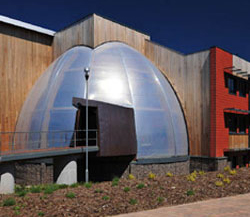What is energy efficiency?

Energy efficiency, means using less energy to provide the same level of energy. It is therefore one method to reduce human greenhouse gas emissions.
For example if a house is insulated, less energy is used in heating and cooling to achieve a satisfactory temperature. Another example is installing fluorescent lights or skylights, instead of incandescent lights, to attain the same level of illumination.
Efficient energy use is achieved primarily by means of a more efficient technology or process. Energy efficient buildings, industrial processes and transportation could reduce the world's energy needs in 2050 by one third, and help controlling global emissions of greenhouse gases.
Making homes, vehicles, and businesses more energy efficient is seen as a largely untapped solution to addressing global warming, energy security, and fossil fuel depletion. The 1973 oil crisis, where oil prices were very high, focussed attention on energy efficiency. For example, the state of California began implementing energy-efficiency laws in the mid-1970s, including building code and appliance standards with strict efficiency requirements. During the following years, California 's energy consumption has remained constant.
Energy-efficient appliances
Refrigerators, freezers, ovens, stoves, dishwashers, and clothes washers and dryers, can be designed to reduce the amount of electricity they use.
Modern energy efficient refrigerators, for example, use 40 percent less energy than those of 2001.
Power management systems also reduce energy usage by idle appliances by turning them off or putting them into a ‘low-energy mode' after a certain time. Many countries identify energy-efficient appliances using an Energy Star or energy efficiency labels.
Energy-efficient building design

The location and surroundings of buildings can help in regulating internal temperature and illumination.
For example, trees, landscaping, and hills can provide shade and block wind. In cooler climates, designing buildings with an east-west orientation to increase the number of south-facing windows minimizes energy use, by maximizing passive solar heating.
Energy-efficient, well located windows, well-sealed doors, and thermal insulation of walls, basement slabs, and foundations can reduce heat loss by 25 to 50 percent.
Smart meters
Smart meters allow a building's energy use to be monitored to assess usage, including peaks and troughs in demand to allow systems to be developed to make the building more energy-efficient.







